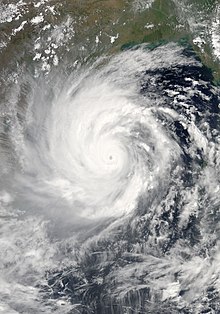User:Super Cyclonic Storm Corona/NIO
Cyclone Amphan[edit]

Super Cyclonic Storm Amphan (/ˈɑːmpɑːn/) was a powerful and catastrophic tropical cyclone that caused widespread damage in Eastern India, specifically West Bengal, and in Bangladesh in May 2020. It was the strongest tropical cyclone to strike the Ganges Delta since Sidr of the 2007 season and the first super cyclonic storm to have formed in the Bay of Bengal since the 1999 Odisha cyclone. It was also the fourth super cyclone that hit West Bengal since 1582, after 1737, 1833 and 1942, as well as being one of the strongest storm to impact the area. Causing over US$13 billion of damage, Amphan is also the costliest cyclone ever recorded in the North Indian Ocean, surpassing the record held by Cyclone Nargis of 2008.
The first tropical cyclone of the 2020 North Indian Ocean cyclone season, Amphan originated from a low-pressure area persisting a couple hundred miles (300 km) east of Colombo, Sri Lanka, on 13 May 2020. Tracking northeastward, the disturbance organized over exceptionally warm sea surface temperatures; the Joint Typhoon Warning Center (JTWC) upgraded the system to a tropical depression on 15 May while the Indian Meteorological Department (IMD) followed suit the following day. On 17 May, Amphan underwent rapid intensification and became an extremely severe cyclonic storm within 12 hours.
On 18 May, at approximately 12:00 UTC, Amphan reached its peak intensity with 3-minute sustained wind speeds of 240 km/h (150 mph), 1-minute sustained wind speeds of 260 km/h (160 mph), and a minimum central barometric pressure of 920 mbar (27.17 inHg). The storm began an eyewall replacement cycle shortly after it reached its peak intensity, but the continued effects of dry air and wind shear disrupted this process and caused Amphan to gradually weaken as it paralleled the eastern coastline of India. On 20 May, between 10:00 and 11:00 UTC, the cyclone made landfall in West Bengal. At the time, the JTWC estimated Amphan's 1-minute sustained winds to be 155 km/h (100 mph). Amphan rapidly weakened once inland and dissipated shortly thereafter.
Coastal areas in West Bengal comprising East Midnapur, North 24 Parganas, South 24 Parganas, Kolkata, Hooghly and Howrah as well as Odisha were affected by the cyclone. It also caused significant destruction in Bangladesh.
Cyclone Fani[edit]
Extremely Severe Cyclonic Storm Fani (/ˈfɒniː/)[a] was the strongest tropical cyclone to strike the Indian state of Odisha since the 1999 Odisha cyclone. The second named storm and the first severe cyclonic storm of the 2019 North Indian Ocean cyclone season, Fani originated from a tropical depression that formed west of Sumatra in the Indian Ocean on 26 April. Vertical wind shear at first hindered the storm's development, but conditions became more favorable for Fani on 30 April. Fani rapidly intensified into an extremely severe cyclonic storm and reached its peak intensity on 2 May, with 1-minute sustained winds equivalent to a Category 5 major hurricane. Fani slightly weakened before making its landfall, and its convective structure rapidly degraded thereafter, degenerating into a remnant low on 4 May, and dissipating on the next day.
Prior to Fani's landfall, authorities in India and Bangladesh moved at least a million people each from areas within Fani's projected path onto higher ground, and into cyclone shelters, which is thought to have reduced the resultant death toll and casualties.[3] Fani killed at least 89 people in eastern India and Bangladesh and caused about US$8.1 billion in damages in both India and Bangladesh, mostly in Odisha, in India.[4]
- ^ "How Cyclone Fani got its name". Dhaka Tribune. 2 May 2019. Retrieved 2 May 2019.
- ^ ঘূর্ণিঝড়ের ফণী নামটি কোথা থেকে এলো? (in Bengali). BBC Bangla. 30 April 2019. Retrieved 2 May 2019.
- ^ Kumar, Hari; Gettleman, Jeffrey; Yasir, Sameer (4 May 2019). "'The Worst Is Over': A Sigh of Relief in India, Mostly Spared by Cyclone". The New York Times. Retrieved 5 May 2019.
- ^ "Global Catastrophe Recap: First Half of 2019" (PDF). Aon Benfield. Retrieved 12 August 2019.
Cite error: There are <ref group=lower-alpha> tags or {{efn}} templates on this page, but the references will not show without a {{reflist|group=lower-alpha}} template or {{notelist}} template (see the help page).
